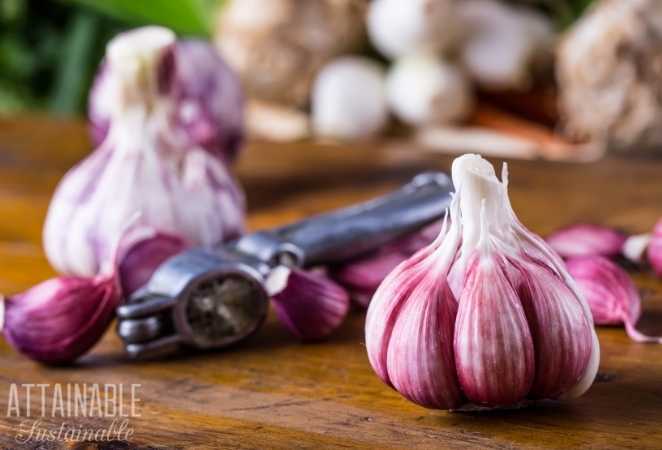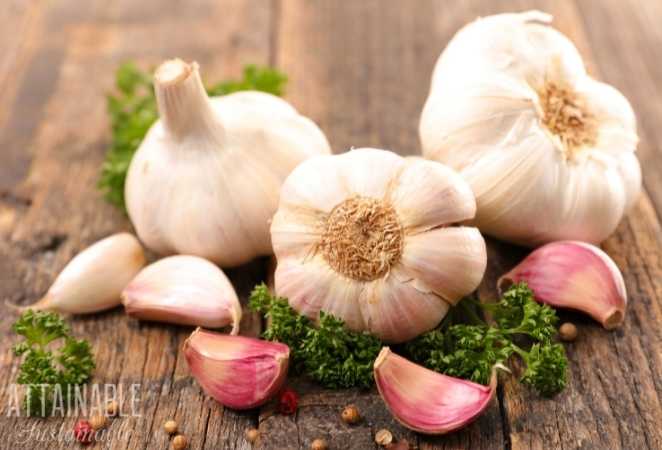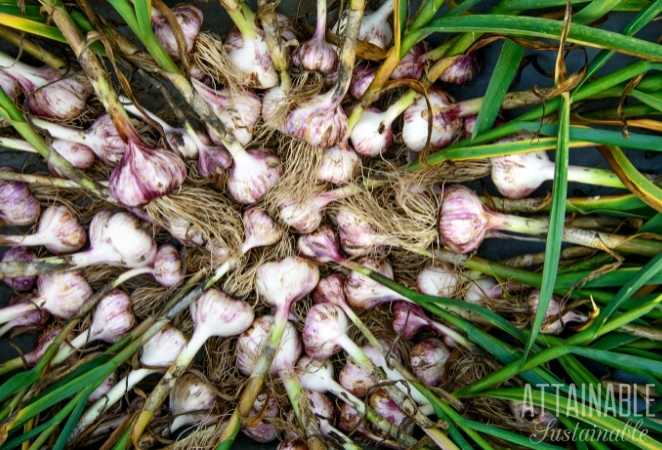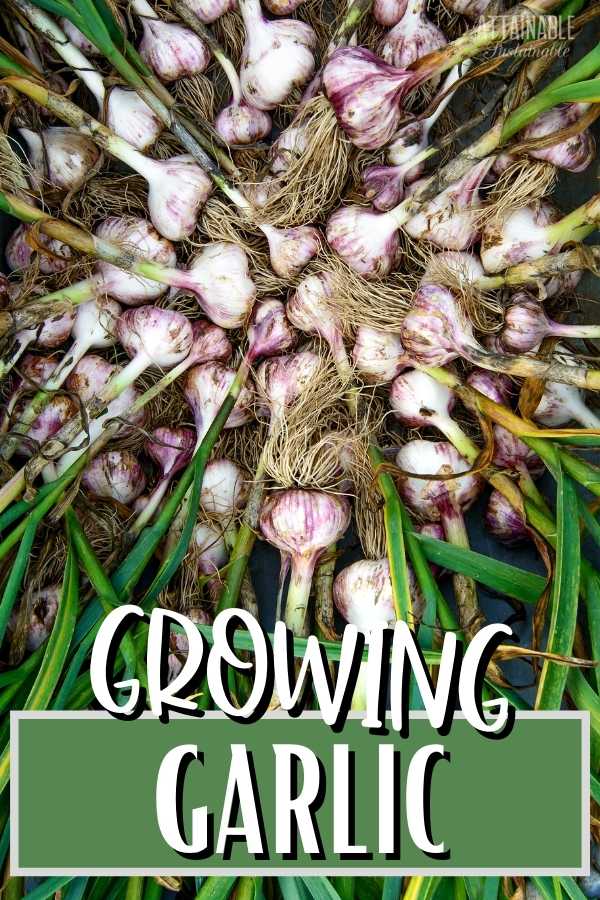Garlic is indispensable for almost every cook, so it is the perfect addition to your garden. Garlic is a member of the lily family and counts leeks, chives, onions, and shallots as its relatives.
If you enjoy savory herbs, you might also want to grow chives at home.
Contributed by Jodi Torpey, author and Master Gardener.
Introduction to Growing Garlic at Home (Allium species)
Garlic is an edible herb that began as a wild plant in Central Asia and then spread throughout the world. Every type of cuisine depends on garlic in one form or another to add flavor and bite to dishes. Fortunately, garlic is adaptable and an easy-to-grow herb for home gardens.
Avoid planting garlic from the grocery store because these bulbs may not have the same disease resistance as seed bulbs. Instead, select fresh garlic seed or bulbs from your local garden center or favorite online retailer. Plant only fresh, unblemished bulbs without any soft spots or other obvious problems.
To decide how much garlic to plant, consider that one pound of garlic bulbs will yield between 8-10 pounds of harvested garlic (a 25-foot row with about 4 inches of space between plants).
Grow Some Greens!
Ready to grow fresh greens, no matter WHERE you live? Sign up for my
FREE quick-start guide and start growing some of your own food!
New to gardening? Limited on space? The 5-Gallon Garden gives you the skills you need to grow food in the space you have. Get started with your garden today!
Garlic varieties
There are many varieties of garlic to choose from, but they all fall into two basic strains or categories: hardneck, and softneck.
Hardneck types are popular for their flavor and produce a flower stalk called a scape that can be used in cooking. Hardneck types are generally hardier for cold weather, easier to peel and can be stored for 3-6 months. Three examples of hardneck varieties include:
Bavarian Purple—A vigorous heirloom garlic that’s popular for its rich, spicy flavor.
Spanish Rojo—Good for growing in colder climates, this garlic features red cloves and rich garlic taste.
Romanian Red—A late-season garlic that grows extra-large heads with purplish-red streaks.
Softneck varieties are preferred by home gardeners and cooks because these are the kind found in grocery stores and often used for braiding. Softneck varieties don’t produce a flower stalk, but are more productive than hardneck garlic. Softneck garlic bulbs can be stored for up to a year. Three examples of hardneck varieties include:
Italian Purple Garlic—Large white, thick-skinned garlic bulbs with purple streaks.
Susanville—A mid-season white-skinned garlic with solid garlic flavor.
Nootka Rose Garlic—A that’s popular for braiding, has rose-colored streaks; adaptable to most climates.
How to Plant Garlic in Your Vegetable Garden
Some gardeners like to soak garlic cloves overnight in liquid kelp before planting to help the garlic start growing quickly. Plant as soon as possible to keep the cloves from drying out.
Avoid planting garlic where garlic, onions or other alliums were grown in the previous 3 years to prevent the potential to spread plant diseases.
In warm-weather regions, you can plant garlic bulbs in fall to grow over winter or in spring as soon as the garden soil can be worked.
In cold-weather areas, plant garlic in fall, 4-6 weeks before the first hard freeze so the garlic can start to root and grow.
Locate a sunny spot and prepare the planting bed by digging in compost to create a rich, well-draining and loose soil. If soil is too dense or compacted, bulbs will be small. Make sure the garlic bed will be convenient to get to for harvesting.
Plant only the largest cloves for large finished garlic bulbs; use the smaller cloves in cooking. Separate cloves from the bulb and plant each with the pointed end up, 1-2 inches (or one clove length) deep and about 4-6 inches apart; space rows about 12-18 inches apart.
Cover with soil, water in deeply. After the ground freezes, add a thick layer of mulch. Straw, chopped leaves or dry, untreated grass clippings will help keep soil moist.
Requirements for Growing Garlic
Light Requirements
If you want good garlic growth with plenty of large bulbs, you’ll need to plant the garlic bed in full sun.
Soil and Fertilizer Needs
Garlic needs a rich, well-draining soil to grow sturdy roots and form big cloves. Feed the garlic crop with either a composted manure or a well-balanced fertilizer as bulbs begin to grow in spring. Some gardeners prefer to use alfalfa meal or liquid fish fertilizer once or twice in spring to encourage growth.
Water Requirements
It’s important to keep garlic from drying out over the winter. If the weather is especially dry, water the garlic when temperatures are warm and there’s little to no precipitation.
Remove the thick mulch from the garlic bed in spring when temperatures are reliably warm. Water as needed to keep the soil consistently moist, but not soggy.
Combatting Common Pests and Other Problems
Garlic is adaptable to most regions and has few pest problems, aside from ordinary garden weeds that can take over the garlic bed and give bulbs competition for space and nutrients. Watch for weeds to start growing and be careful not to disturb garlic roots when pulling weeds.
If the bulb or neck of the garlic plants start to rot, a soil fungus is usually to blame. Avoid this problem by making sure the garden soil is well-draining to begin with.
How to Grow Garlic in Containers
You can plant garlic in containers by themselves or add to containers planted with other vegetables that have similar sun, water and nutrient needs. If you plant in a large container, there will be more space to allow bulbs to grow. Plant and space as you would if planting cloves in a garden bed.
If the bulbs aren’t forming to your expectations, you can use the garlic greens to chop and add to recipes.
Harvesting Garlic
If you planted hardneck garlic, watch for the tall flower stalks called scapes to emerge and cut them while they’re still young and tender. Bulbs will grow larger if the plant’s energy isn’t spent on producing a stalk and aerial cloves called bulbils. Leave one scape intact and when it unfurls, the garlic is ready to harvest.
Use the cut scapes for grilling, sautéing or stir frying to add a taste of garlic.
Softneck garlic is ready to harvest when about half the leaves yellow and dry. When leaves start to turn yellow, stop watering. Wait about 2 weeks for the bottom leaves to turn brown, then use a garden fork to carefully lift the entire plant from the soil. Be sure not to damage the soft bulbs during harvest.
Cure the fresh garlic by tying together in small bundles and dry in a cool, shaded location for 3-4 weeks. Creative gardeners create garlic braids with softneck varieties to hang in a cool dark place to cure.
Once cured you can cut the leaves and roots from the garlic heads and store in mesh bags to allow for air circulation.
Using Homegrown Garlic in the Kitchen
Besides using fresh garlic in recipes, here are a few other ideas:
- Bake whole garlic bulbs to spread on toast (like this Texas Toast)
- Chop and mix into soft butter
- Utilize in Pesto or this five ingredient Cilantro sauce
- Roast cloves with other vegetables
- Use in Garlic Mashed Potatoes
- Chop and mix with olive oil, then freeze to use in cooking
- Pickle the garlic cloves
Saving Garlic Bulbs and Seeds
Garlic is a crop that supplies gardeners with the seeds for planting the next season by storing some of your biggest and best heads for replanting.
If you’re a gardener who likes to experiment, you can let a few of the hardneck garlic scapes bloom and go to seed. Harvest the bulbils, separate the seeds and store for the next season. The garlic probably won’t be the same as what you originally planted, but may yield something a little different.












I’ve wanted to plant garlic, and you’ve provided enough info here that I’m more confident about what to do to ensure I don’t waste a season or space killing it. Thank you!
You’re welcome! Glad it helped 🙂